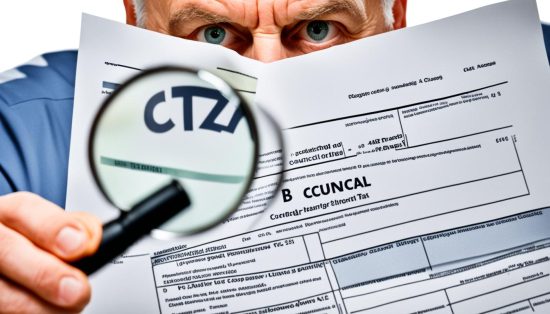Last Updated on: 19th October 2024, 05:59 am
As homeowners or tenants, understanding the intricacies of council tax bands is crucial since these billing codes play a significant role in how local government tax is calculated on your dwelling.
In the realm of domestic tax rates, the valuation of your property isn’t simply a matter of current market prices. Rather, it’s tied to historic values that could impact your taxation categories significantly.
Across the pond, in UK jurisdictions, these annual residential assessments are conducted by the Valuation Office Agency (VOA) which categorizes homes into bands based on their value on a specific past date.
Although Canada doesn’t use the same system, understanding it helps expats or those dealing with properties abroad where council tax bands heavily influence homeowner expenses.
In essence, each band reflects a range of values that, when applied, determines the domestic tax rates you are liable to pay.
Being aware of your property’s band can help you manage your finances better and ensure you’re not overpaying on your local council’s tax demands.
Understanding Council Tax Bands
Grasping how council tax bands are structured is essential for property owners to ensure they are fairly assessed in terms of municipal levies and household charges.
The valuation of a property plays a pivotal role in this classification, influenced by several core factors which are assessed on specific valuation dates.
Factors Determining Council Tax Bands
The categorization into different council tax bands is significantly influenced by a property’s rateable values, which include considerations of size, layout, and character.
Moreover, the property’s location and any changes in its use also impact its assessment. Significant alterations or conversions can prompt a re-evaluation, potentially altering its tax band.
Valuation Dates for Council Tax Banding
Property valuations are anchored to specific dates which bear historical significance. In England, the valuation date crucial for determining council tax bands is April 1, 1991.
Conversely, in Wales, property evaluations relevant for council tax purposes are traced back to April 1, 2003. These dates are fundamental as they set the benchmark for the property valuations used to assign the appropriate municipal levies.

Understanding these factors and dates is critical for homeowners and potential buyers to navigate the complexities of household charges and ensure compliance with municipal requirements.
It’s also beneficial for ensuring one’s property is fairly assessed, avoiding overpayment due to incorrect banding.
Council Tax Bands – A Breakdown
Understanding the range of council tax bands is essential for accurately assessing the rateable values of properties and ensuring that residential assessments are fair and precise.
Below is a detailed breakdown of the Council Tax Bands from A to H as they are applied based on property values from historical assessments.
This spectrum helps determine the amount of council tax owed by property owners in different valuation brackets.

Band A: Properties Up to £40,000
Properties falling in Council Tax Band A are valued up to £40,000. This band typically includes smaller apartments or modest houses, which represent the most affordable sector in housing when it comes to council taxes.
Band B: Properties £40,001 to £52,000
This Council Tax Band B captures properties that are slightly higher in value than those in Band A, encompassing a range of residential spaces that offer moderate amenities and size, reflected in their slightly higher tax contribution.
Band C: Properties £52,001 to £68,000
Council Tax Band C includes homes that are valued between £52,001 and £68,000. This range covers a significant segment of the residential market, including family homes in developing areas.
Band D: Properties £68,001 to £88,000
Often considered the middle range, Council Tax Band D addresses properties that represent the median residential assessments, balancing property size and location quality against tax affordability.
Band E: Properties £88,001 to £120,000
Properties in the Council Tax Band E category are higher in value, likely due to their larger size, better location, or quality of construction, leading to a higher tier of council tax.
Band F: Properties £120,001 to £160,000
Band F properties reflect a more luxurious range of housing, with significant amenities and exclusive locales, justifying their higher placement in the council tax hierarchy.
Band G: Properties £160,001 to £320,000
This band encompasses premium properties that offer expansive living spaces and are situated in the most sought-after areas, resulting in substantial rateable values.
Band H: Properties Over £320,000
The highest council tax band, Band H, includes properties valued over £320,000. They represent the pinnacle of residential luxury and thus attract the highest council tax rates.
Banding for New Properties and Conversions
When it comes to managing new property council tax banding, understanding the process is essential for homeowners and developers alike.
Properties that have recently been constructed or converted for domestic use must be assessed to fall under the appropriate council tax band, a key component of local government tax.
This not only helps in determining the tax liability but also ensures fairness and uniformity in residential assessments.

Typically, the occupants of these new or newly converted properties are required to contact their local council.
This initiates the process whereby the Valuation Office Agency (VOA) assigns a suitable tax band.
It’s important to be proactive in this engagement to avoid potential complications or delays in the assessment process.
| Step | Action Required | Responsible Party |
|---|---|---|
| 1 | Notify the local council of the completion of construction or conversion. | Property Owner/Developer |
| 2 | Submission of property details and supporting documentation. | Property Owner/Developer |
| 3 | Inspection and assessment by the Valuation Office Agency. | VOA |
| 4 | Allocation of council tax band according to assessed value. | VOA |
| 5 | Receive notification of new tax banding and commence payment. | Property Owner |
This streamlined approach ensures that every new or converted property gets the attention it requires for appropriate residential assessments and local government tax responsibilities.
Challenging Your Council Tax Band
If you believe your property has been placed in an incorrect tax band, you have options available to challenge this designation and potentially reduce your payment obligations.
Understanding the process to challenge council tax band is essential for any property owner, especially when taking into account various taxation categories and the potential for appealing council tax valuation inaccuracies.
Grounds for Challenging a Band
Property owners can initiate an appeal if they believe that the valuation which determined their council tax band was incorrect.
This might include changes in the property’s structure, its environment, or other factors that significantly alter its value.
To successfully challenge council tax band, the proposer usually needs to provide evidence of similar properties in the area that display a discrepancy in banding.
This process is aimed at ensuring fairness and consistency across tax assessments.
The Appeals Process
The process to appeal council tax valuation entails a thorough review by the Valuation Office Agency (VOA) after a formal challenge has been submitted via the appropriate channels.
The evidence submitted is crucial; it should include details that highlight why the property’s band is perceived as incorrect.
Adjustments in taxation categories may also influence the appeal, necessitating a clear understanding of the relevant legal guidelines and taxation framework.
If the challenge is accepted, a reevaluation of the property is conducted, which may lead to a band adjustment. This process underscores the importance of accurate taxation categories in council tax assignments.

Valuation Office Agency Inspections
When it comes to understanding your council tax assessment, the role of VOA property inspections cannot be understated.
These inspections are essential in ensuring that each property is fairly assessed for council tax purposes, reflecting appropriate municipal levies.
What to Expect During an Inspection?
The process is designed with homeowner privacy in mind. Typically, a VOA inspection is quick and efficient, often not requiring access to the inside of your home.
Inspectors carry official identification at all times, reinforcing the legitimacy and professionalism of the inspection.
If there’s a need for an internal inspection, rest assured that such requests are handled with the utmost respect for your privacy.
Photographs or detailed notes inside your property are only taken with your explicit consent. In such events, homeowners have the right to verify the inspector’s credentials directly with the Valuation Office Agency.
Understanding these processes helps demystify aspects of council tax assessments and underlines the importance of VOA property inspections in determining accurate municipal levies for homeowners.
Special Cases: HMOs, Holiday Lets, and Annexes
When addressing the complexities of property taxes in unique housing situations, several categories stand out.
These include houses in multiple occupations (HMOs), holiday let properties, and annexes. Each of these property types face distinct tax rules that can significantly impact their valuation and tax responsibilities.
1. Banding Rules for HMOs
HMO council tax bands are specifically structured to adapt to the unique nature of these properties. Unlike regular residential properties that receive individual bands, HMOs might be banded singularly despite having multiple tenants. This arrangement changes the way taxes are strategized for property owners.
2. Holiday Lets and Business Rates
The valuation of holiday lets often leads to the application of business rates for holiday lets instead of standard council taxes if these properties are let out for short-term stays frequently through the year.
This distinction aids in maximizing revenue from tourism while ensuring compliance with local tax laws.
3. Annexes and Self-Contained Units
Moreover, annex taxation categories cater to structures that are attached to, or within the grounds of, a main property but are used as separate dwellings. These may be taxed separately under certain conditions, depending on their independent usage and facilities.
| Property Type | Tax Category | Notes |
|---|---|---|
| HMOs | Council Tax | Typically banded as one unit despite multiple occupants |
| Holiday Lets | Business Rates | Applies if available for letting 140 days or more per year |
| Annexes | Council Tax/Business Rates | Taxed based on being self-contained or part of larger dwelling |
Conclusion
Wrapping up our detailed exploration, it becomes clear that comprehending council tax bands is not merely bureaucratic necessity but a linchpin in managing local government tax responsibilities.
These bands serve as a compass, guiding residential property owners through the mazes of taxation, securing assurance that their contributions are proportional to the valuation of property within their dominion.
The mechanisms behind these assessments and the allocation of new property bands are fundamental in maintaining this calibrated system of municipal levies.
Furthermore, the need for vigilance is underscored by the capacity to challenge potentially erroneous placements within this framework.
Awareness of the procedures to contest and appeal against council tax bands catalyzes the pursuit of equitable tax rate exemptions.
This recourse is pivotal for owners who find discord in their designated band and valuation, ensuring the principle of fairness is upheld within the domain of local taxation.
In special scenarios, encompassing HMOs, holiday lets, and annexes, knowledge of council tax regulations is particularly consequential, anchoring tax obligations to the nature and use of such properties.
Allowing no detail to slip through the cracks, this comprehensive guide vests property owners with the knowledge to secure rightful fiscal positions, presenting exemptions and reductions as accessible options should their situations align with qualifying criteria.
Thus, our expedition through the byways of council tax bands concludes, leaving proprietors well-equipped to navigate their local government tax with confidence and precision.
FAQ
1. Which is the highest council tax band, A or D?
The highest council tax band is D in the range from A to D. However, council tax bands in total range from A to H, with H being the highest band.
2. How much is council tax band C in London?
The amount for council tax band C in London varies by borough. To determine the exact amount, it’s best to consult the local council’s website for updated rates.
3. What council tax band is the cheapest?
Council tax band A is the cheapest as properties in this band are valued up to £40,000, making it the lowest valuation bracket.
4. Who is exempt from paying council tax in the UK?
Exemptions from council tax in the UK apply to full-time students, people under 18, those with severe mental impairments, and live-in carers, among others. Some properties like student halls of residence or those occupied only by minors are also exempt.
5. Does everyone pay council tax in the UK?
Most adults who occupy a residential property in the UK are liable to pay council tax. However, there are various exemptions and discounts available based on the occupants and property type.
6. At what age do you stop paying tax in the UK?
There is no age limit for stopping payment of taxes like council tax in the UK, as this is based on the occupation of property and not age. However, pensioners may qualify for council tax reduction based on income and other criteria.
7. Can I challenge my council tax band?
Yes, property owners can challenge their council-tax band if they believe it’s incorrect. They can do this through the Challenge Your Council Tax Band service on the Gov.uk website, potentially leading to a reassessment by the VOA.




















No Comments
Leave a comment Cancel